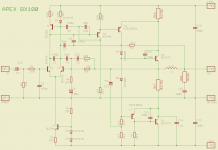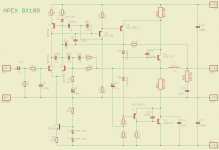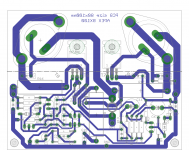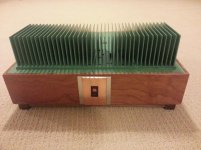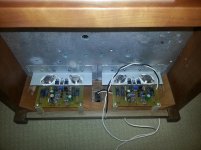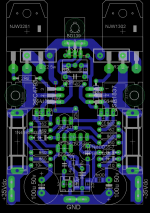This is my AX-11 base on borys layout. PCB is very small 😱 and working crystal clear, dead silent and no power on thump... nice amp..😉
Have you had boards made? or did you make this board yourself?
I'd like a few of those bare boards, if you have extras.
You can try with this one... 🙂
Regards
I'll give it a shot.
Using eagle. Let's verify that I captured the schematics without mistakes, then I'll work on board layout.
The 2N3773 being TO3, to avoid any extra wires, I'll make the board so we can have the heatsink on the board.
Attachments
I have a doubt about the polarized caps from my previous schematic. The ones I called C6 and C11 (they're not named on the original sch). Logically I would think C6 should be bipolar, but on the original schematic, C6 and C11 are inverted in relation to each other, and C11 should have its negative end towards the V- rail. So that one is reversed and wrong on my schematic. But then what about C6?
I made a change to my schematic. I reversed C11 but left C6 as it was. Tell me if I'm wrong. I think C6 would be better as a bipolar.
I made a first shot pcb layout. So bring in the comments and let's improve on it.
The board is half a euro size (80x100mm), but almost half of the real estate is used for the heatsink. Those TO3 take some room...
This amp would only run as class B. Perhaps we could add a bias adjustment and push it to class AB. I would use a TO126, maybe a BD139 or something like that and it would go on the heatsink as well.
I made a first shot pcb layout. So bring in the comments and let's improve on it.
The board is half a euro size (80x100mm), but almost half of the real estate is used for the heatsink. Those TO3 take some room...
This amp would only run as class B. Perhaps we could add a bias adjustment and push it to class AB. I would use a TO126, maybe a BD139 or something like that and it would go on the heatsink as well.
Attachments
Nice.... As long as you use light bulb in series with your trafo on the first fire up you have nothing to worry.😉
Regards,
Regards,
Have you had boards made? or did you make this board yourself?
I'd like a few of those bare boards, if you have extras.
I made the board myself to test my layout.
Nice.... As long as you use light bulb in series with your trafo on the first fire up you have nothing to worry.😉
Regards,
Willy,
Thanks
As we have 120v, is 40w bulb good enough?
Albert
Willy,
Thanks
As we have 120v, is 40w bulb good enough?
Albert
40w is very low, I suggest 100W.
I made the board myself to test my layout.
Cool, so you know for sure it works fine and without issues.
The board being so tiny, makes the much cheaper to manufacture, but I was checking of having a board like this made and it would be at least 70 euros (plus shipping) to make one, and at the cheapest board maker that I know of. Then while increasing the quantity, I found that having 10 boards made would cost the same exactly, and the cost per board continuing to go down from there, below 7 euros per board (plus ship), this can become feasible, as long as the purchased quantity is well over 10 boards. So this seems like a group buy possibility, if that amp gets a bit of popularity, the quantity could reach 100 maybe...
This would require making gerbers, and while doing this, perhaps making last minute fine tuning on the layout.
Willy,
Thanks
As we have 120v, is 40w bulb good enough?
Albert
I have to work with 240Vac so I can't be sure about how 120Vac bulbs will operate on 120Vac mains.40w is very low, I suggest 100W.
I would expect a 40W bulb to start up any 120Vac transformer.
I would also expect a 40W bulb to start up and charge a medium sized capacitor bank.
Once you add on an amplifier the bulb needs to be rated to suit the quiescent current of the amplifier + load of starting the transformer and charging the capacitor bank.
On 240Vac I use 25W and 40W for transformer and PSU testing.
I use 40W and 60W for upto 100W ClassAB amplifier start ups.
I have 100W and 150W bulbs, but rarely need to use them.
In my view it is always worth starting with a smaller bulb. It is easy to swap to a bigger bulb if you find the smaller continues to glow after achieving normal operational voltages (they will be a bit low due to low voltage applied to the transformer).
My amp is slowly coming up. I still hesitate a bit when time of firing up. Any advice would be appreciate.
Albert
Looking good!
Here is mine. Strait derived from Borys one. I just made some slight changes to use Panasonics FC caps, Mica-Ag for signal to ground caps. I use some SMD resistors and caps to save space. Panasoncics and Mica-AG take a uge amount of room on a so little board. (54*65mm). I use NJW3281/1302. This nice little board can fit quite good to Home theatre project with 5 chanel in one box.
Marc
Marc
Attachments
I made a change to my schematic. I reversed C11 but left C6 as it was. Tell me if I'm wrong. I think C6 would be better as a bipolar.
I made a first shot pcb layout. So bring in the comments and let's improve on it.
The board is half a euro size (80x100mm), but almost half of the real estate is used for the heatsink. Those TO3 take some room...
This amp would only run as class B. Perhaps we could add a bias adjustment and push it to class AB. I would use a TO126, maybe a BD139 or something like that and it would go on the heatsink as well.
Nice work, this is class B hi-fi amplifier like QUAD 405 no need to change it to class AB there is many class AB amplifiers in this thread. BC546/556can be use with +/-56V maximum but if you want higer rail voltager use 2N5401/5551 and add two more pairs of output like in QUAD 606.
Regards
Here is mine. Strait derived from Borys one. I just made some slight changes to use Panasonics FC caps, Mica-Ag for signal to ground caps. I use some SMD resistors and caps to save space. Panasoncics and Mica-AG take a uge amount of room on a so little board. (54*65mm). I use NJW3281/1302. This nice little board can fit quite good to Home theatre project with 5 chanel in one box.
Marc
Nice PCB, AX11 is very usefull aplifier,
Regards
I have to work with 240Vac so I can't be sure about how 120Vac bulbs will operate on 120Vac mains.
I would expect a 40W bulb to start up any 120Vac transformer.
I would also expect a 40W bulb to start up and charge a medium sized capacitor bank.
Once you add on an amplifier the bulb needs to be rated to suit the quiescent current of the amplifier + load of starting the transformer and charging the capacitor bank.
On 240Vac I use 25W and 40W for transformer and PSU testing.
I use 40W and 60W for upto 100W ClassAB amplifier start ups.
I have 100W and 150W bulbs, but rarely need to use them.
In my view it is always worth starting with a smaller bulb. It is easy to swap to a bigger bulb if you find the smaller continues to glow after achieving normal operational voltages (they will be a bit low due to low voltage applied to the transformer).
Andrew,
Thanks. N I try small one to start.
Looking good!
Carl,
I try hard to make it fast, but limited skill slows me down.
Here is mine. Strait derived from Borys one. I just made some slight changes to use Panasonics FC caps, Mica-Ag for signal to ground caps. I use some SMD resistors and caps to save space. Panasoncics and Mica-AG take a uge amount of room on a so little board. (54*65mm). I use NJW3281/1302. This nice little board can fit quite good to Home theatre project with 5 chanel in one box.
Marc
I think soldering smd parts is for those who still have a good eyesight and steady hands. I myself would never attempt to solder such parts (I'm too old for this now).
One thing that would be nice though is to try to get rid of the straps. And if using smd parts is just to stay within the original board size, then why not make the board a tiny bit wider, there is no physical limit to the board size, it turned out that way but there is nothing wrong with increasing its size a little.
If there are no smd parts to solder, I would consider building that little amp...
Willy,
Thanks
As we have 120v, is 40w bulb good enough?
Albert
Hot bulb resistance is R=U2/P, hot 100W/220V bulb have resistance 484 Ohms. If you want same resistance with 120V bulb must be 30W (P=U2/R),
Regards
- Home
- Amplifiers
- Solid State
- 100W Ultimate Fidelity Amplifier
